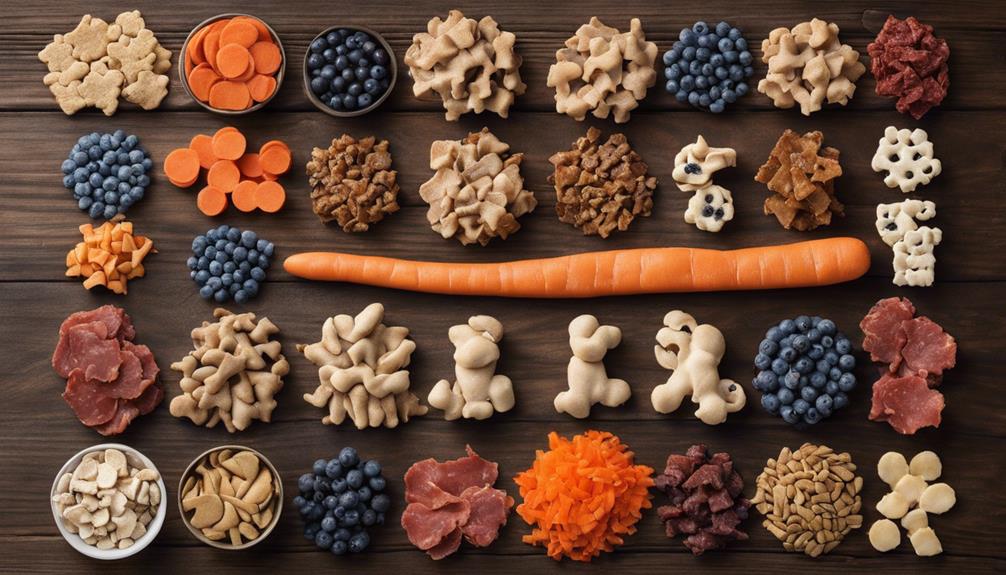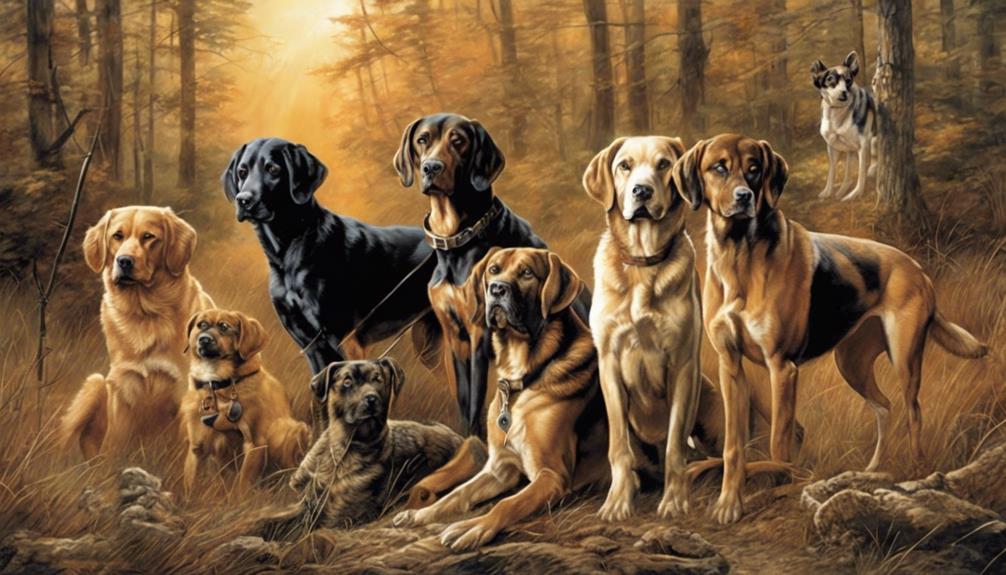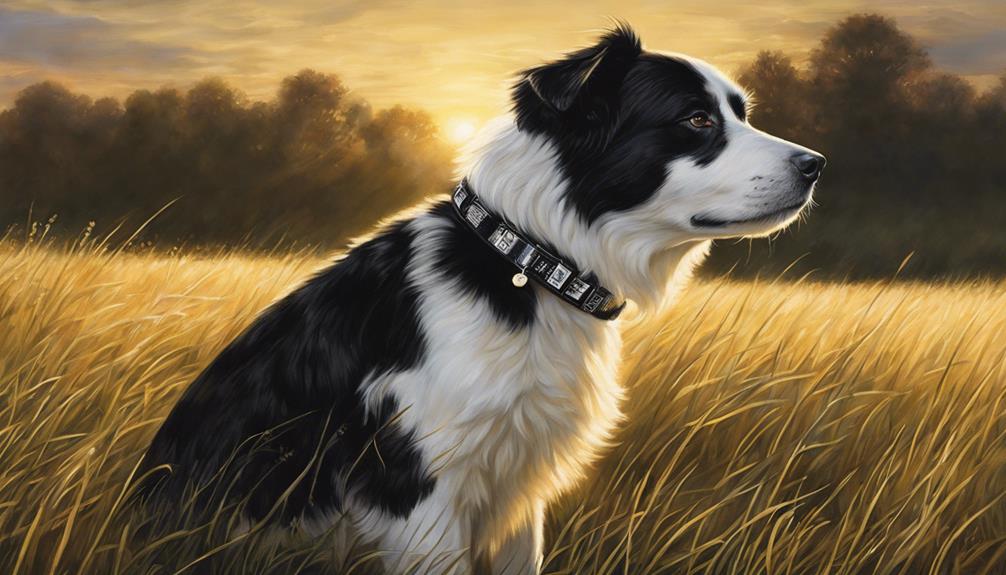When you’re picking out natural dog training treats, opt for those that contain wholesome ingredients like real meats such as chicken, beef, lamb, and fish which help with muscle development and energy. Look for treats that have organic flavors and colors derived from fruits, vegetables, and spices, as these can enhance your pet’s overall health. Nutrient-rich fruits like blueberries and apples, as well as vegetables such as sweet potatoes and carrots, provide essential nutrients and antioxidants for your dog.
Moreover, high-quality protein sources and recognizable ingredients on the label are vital for choosing the best treats. By focusing on these key elements, you can guarantee your furry friend's health and training success.
Key Takeaways
- Choose treats with high-quality protein for muscle development and energy.
- Opt for natural flavors and colors derived from real ingredients.
- Include nutritious fruits and vegetables for vitamins and antioxidants.
- Use specialized training treats with limited ingredients for quick rewards.
- Prioritize sustainably-sourced ingredients, variety, and portion control for optimal health benefits.
Benefits of Natural Dog Treats
Natural dog treats offer numerous benefits for your furry companion's health and well-being. By using wholesome ingredients and avoiding artificial additives, these treats play a crucial role in enhancing your natural dog's overall health.
The absence of artificial additives, colors, and preservatives in these treats contributes to better digestion and nutrient absorption in dogs. Additionally, natural treats contain higher levels of vitamins, minerals, and antioxidants, providing essential nutrients that support your dog's immune system and well-being.
Key Ingredients to Look For
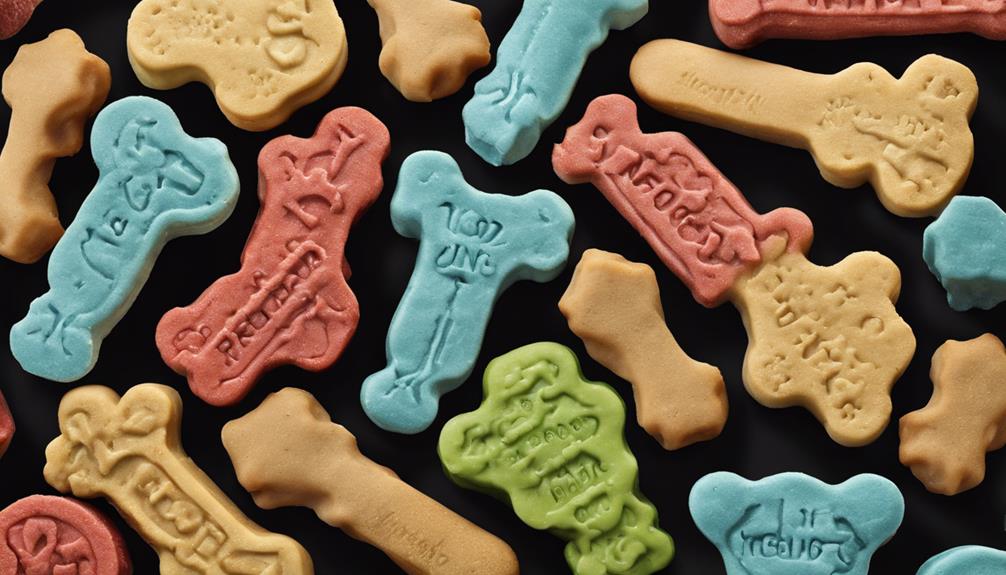
When selecting natural dog training treats, prioritize key ingredients like:
- high-quality protein sources
- organic flavors and colors
- nutritious fruits and vegetables
These components guarantee your dog receives essential nutrients for overall health and well-being. Opting for treats with these ingredients helps bolster your dog's training and rewards them with wholesome goodness.
Quality Protein Sources
For peak health and energy levels in your furry companion, prioritize seeking dog training treats that contain high-quality proteins such as real meats like chicken, beef, lamb, and fish.
When selecting a protein treat, make sure it has high protein content to support muscle development and energy. Choose treats with single ingredients, such as real meats, to provide a wholesome and nutritious snack for your dog.
Avoid treats with vague protein sources like 'meat by-products' or fillers like corn or soy, as these may not offer the same benefits. Look for protein-rich ingredients like whole meat or meat meal listed as the first ingredient on the treat label for the most nutritional value.
Natural Flavors and Colors
Look out for dog training treats that boast enticing flavors and vibrant colors derived from real ingredients like fruits, vegetables, and spices. When choosing healthy treats for dogs, it's crucial to pay attention to the source of these flavors and colors. Opt for treats with natural ingredients like real meat, fruits, and vegetables to ensure your furry friend gets a tasty and nutritious reward. Avoid artificial flavors and colors, as they may not only lack the nutritional benefits of natural ingredients but could also have negative effects on your dog's health. By selecting treats with recognizable ingredients on the label, you can be confident that your dog is enjoying a delicious snack that is both safe and beneficial.
| Natural Ingredients | Artificial Colors | Artificial Flavors |
|---|---|---|
| Real meat | Avoid | Avoid |
| Fruits | Avoid | Avoid |
| Vegetables | Avoid | Avoid |
Nutritious Fruit and Vegetables
Including a variety of nutritious fruits and vegetables in your dog's training treats can boost their health and make training sessions more enjoyable for them. Look for treats with nutritious fruits like blueberries, apples, and bananas, providing vitamins, antioxidants, and fiber for your dog's health.
Vegetables such as sweet potatoes, carrots, and peas are excellent ingredients in training treats, offering essential nutrients and natural sweetness. These ingredients are often rich in phytonutrients, which support your dog's immune system and overall well-being.
Opting for treats with real fruits and vegetables can help maintain a balanced diet for your dog while keeping their training sessions engaging and rewarding.
Training Treats Vs. Regular Treats

When selecting treats for training your dog, choose specialized training treats over regular treats for maximum effectiveness. Training treats, such as Chewy Dog or freeze-dried dog treats, are designed to be small, tasty, and easy to chew, making them ideal for quick rewards during training sessions. These treats often have limited ingredients, which can be beneficial for dogs with food sensitivities.
In contrast, regular treats may not be as motivating or suitable for training purposes due to their size, ingredients, or nutritional content. Training treats generally have higher value to dogs, making them more effective in reinforcing desired behaviors. Their size and texture are perfect for frequent use during training sessions, helping to maintain your dog's focus and engagement.
Homemade Treat Recipes
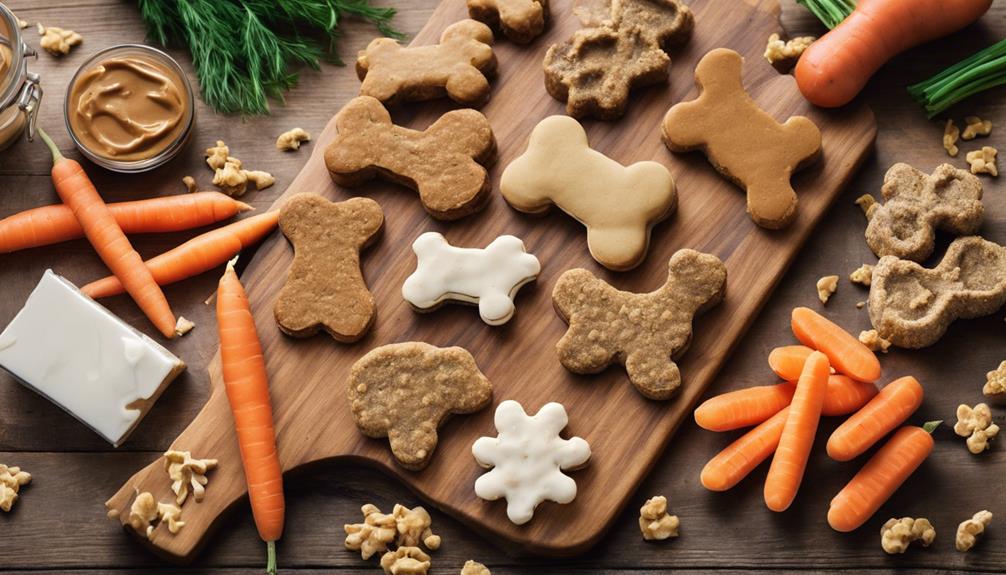
When crafting homemade dog treats, you have the chance to manage the ingredients and guarantee quality for your furry companion. By customizing the treats to meet your dog's particular dietary requirements and preferences, you can offer a personalized snack they'll adore.
Following straightforward ingredient lists and simple baking instructions can lead to tasty treats that aren't only budget-friendly but also support your dog's overall health and well-being.
Simple Ingredient Treats
For simple ingredient homemade treats that cater to your dog's preferences and dietary needs, try crafting recipes with common staples like peanut butter, pumpkin, oats, and eggs. These treats offer a healthy dog snack option that's free from artificial additives commonly found in store-bought treats. When making homemade treats, you have control over the ingredients, ensuring they're tailored to your furry friend's requirements.
Popular recipes include:
- Peanut butter and banana treats
- Sweet potato chews
- Pumpkin pupcakes
Experiment with these simple ingredients to create delicious and nutritious treats that your dog will love. Making your own treats can be both rewarding for you and beneficial for your canine companion.
Easy Baking Instructions
Crafting homemade dog treats is a simple and enjoyable way to provide your furry companion with delicious and nutritious snacks tailored to their needs.
When it comes to baking your own treats, start by preheating your oven and gathering the necessary ingredients like peanut butter, oats, and pumpkin.
Mix the ingredients together to form a dough, then shape it into bite-sized pieces or use cookie cutters for fun shapes.
Place the treats on a baking sheet and bake until they're golden brown and crispy. Once cooled, store them in an airtight container to maintain freshness.
Following straightforward baking instructions like these guarantees that your homemade treats aren't only tasty but also beneficial for your dog's health.
Tips for Choosing the Best Treats
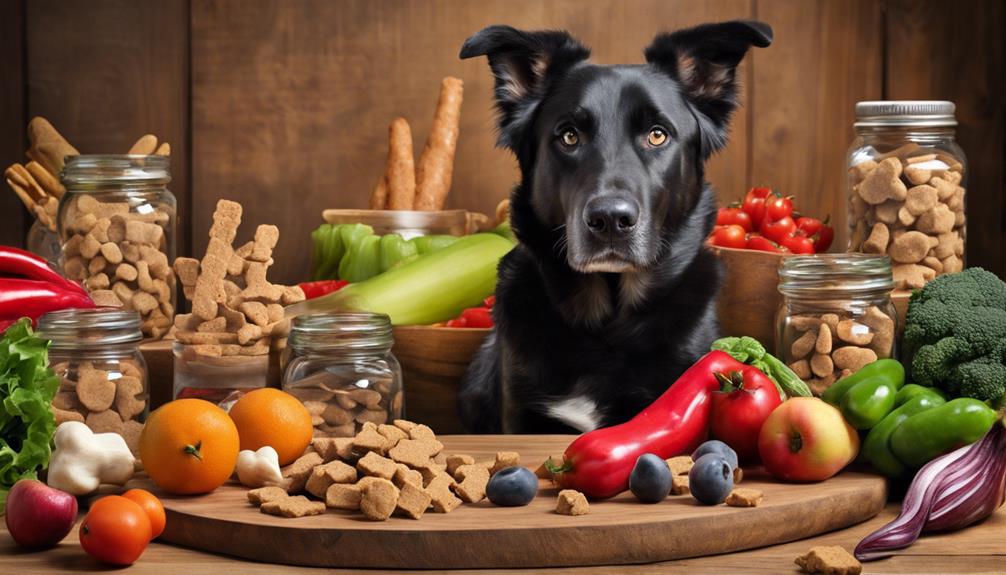
To choose the best treats for your dog's training, consider prioritizing sustainably-sourced ingredients and a variety of flavors and textures in all-natural options.
When selecting treats, keep in mind the following tips:
- Sustainably-sourced Ingredients: Look for treats that are made with sustainably-sourced ingredients to guarantee both your pet's health and environmental well-being are taken care of.
- Variety of Flavors and Textures: Opt for treats that come in a range of flavors and textures to cater to your dog's preferences and make training sessions engaging and enjoyable.
- Limited Ingredient Options: Choose mini-sized, single-ingredient, or grain-free treats to accommodate various training needs and dietary restrictions effectively.
Portion Control and Frequency

Maintaining proper portion control and regulating treat frequency are vital aspects of managing your dog's diet and overall health. When it comes to dog food, soft and chewy training treats can be irresistible, but it's important to exercise caution in their distribution. Treats should make up no more than 10% of your dog's daily caloric intake to prevent overfeeding and weight gain. To help you visualize the importance of portion control and frequency, refer to the table below:
| Portion Control | Frequency |
|---|---|
| Limit treats to 10% | Align with activity level |
| Consider treat size | Monitor consumption |
| Break treats into smaller pieces | Adapt to overall diet |
| Prevent overfeeding | Avoid health issues |
Incorporating Treats Into Training Routines

When integrating treats into your dog's training routine, focus on using them as positive reinforcements to enhance the bond between you and your furry companion. Incorporating natural ingredients in your dog training treats can benefit both your pet's health and your training sessions.
Here's how you can effectively include treats in your training routines:
- Choose high-quality natural dog training treats: Opt for brands like Only Natural Pet, Zukes, or Orijen that offer treats with sustainably-sourced ingredients.
- Use treats as rewards for desired behaviors: Positive reinforcement is key in training sessions, so make sure to reward your dog with treats when they exhibit the behaviors you're trying to teach.
- Consider the preferences of your dog: Dogs have different tastes, so having varied flavors and textures in all-natural training treats can cater to your canine companion's preferences and keep them engaged during training sessions.
Avoiding Harmful Additives and Fillers
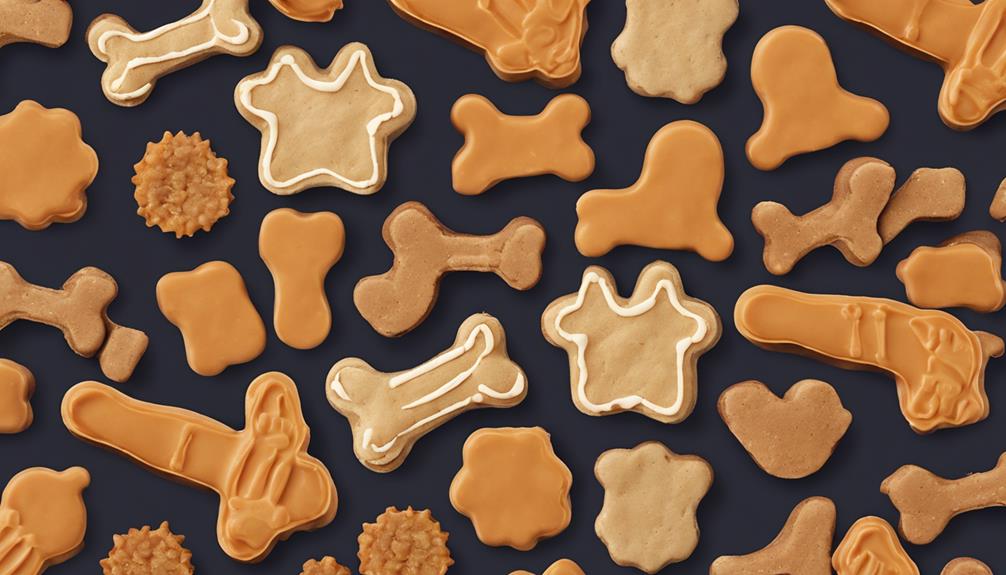
Selecting dog treats without harmful additives and fillers is crucial for maintaining your pet's health and well-being. Harmful additives such as synthetic colors, flavors, and preservatives can result in various health issues in dogs. Fillers like maize, soy, and secondary products offer little to no nutritional value for your furry friend.
To guarantee you're providing your dog with safe and healthy treats, make sure to inspect the ingredient labels carefully. Choose treats made in reputable facilities to decrease the risk of harmful additives and fillers in your dog's diet. Avoiding synthetic colors and flavors can aid in preserving your dog's overall health and well-being.
Frequently Asked Questions
What Are the Best Natural Training Treats for Dogs?
When training your dog, opt for natural treats like freeze-dried raw or grain-free options. Brands like Only Natural Pet and Zukes offer quality choices. With prices ranging from $6.74 to $14.99, there are options for every budget.
What Do Most Dog Trainers Use for Treats?
Most dog trainers use all-natural training treats made with high-quality ingredients. Options like freeze-dried raw treats, grain-free choices, and soft varieties are popular. Brands such as Only Natural Pet, Zukes, and Orijen are recommended.
What Are the Top 10 Healthiest Dog Treats?
To keep your pup healthy, choose treats like Real Dog Box, SmallBatch, and Green Juju Kitchen. These options provide quality protein and natural ingredients. Opt for healthy cookies from Avas Pet Palace and City Bones too.
What to Avoid in Dog Training Treats?
When choosing dog training treats, avoid artificial colors, flavors, and preservatives that harm your furry friend. Skip fillers like corn, soy, or wheat, which offer little nutrition. Check for by-products and excess sugar or salt to keep your pup healthy.
Can Homemade Dog Training Treats Be as Effective as Natural Ones?
When it comes to training your dog, the quality of the treats you use can make a big difference. Many pet owners wonder if homemade dog training treats can be as effective as natural ones. With the right homemade dog training treats recipe, you can create healthy and enticing rewards for your furry friend.
Conclusion
Remember, when choosing natural dog training treats, prioritize ingredients like turkey, sweet potato, and blueberries for maximum health benefits.
Practice portion control to avoid overfeeding, and incorporate treats strategically into your training routines.
Avoid harmful additives and fillers by reading labels carefully.
By following these tips and recipes, you'll be on your way to successful training sessions with your furry friend.
Happy training and treat time awaits!
